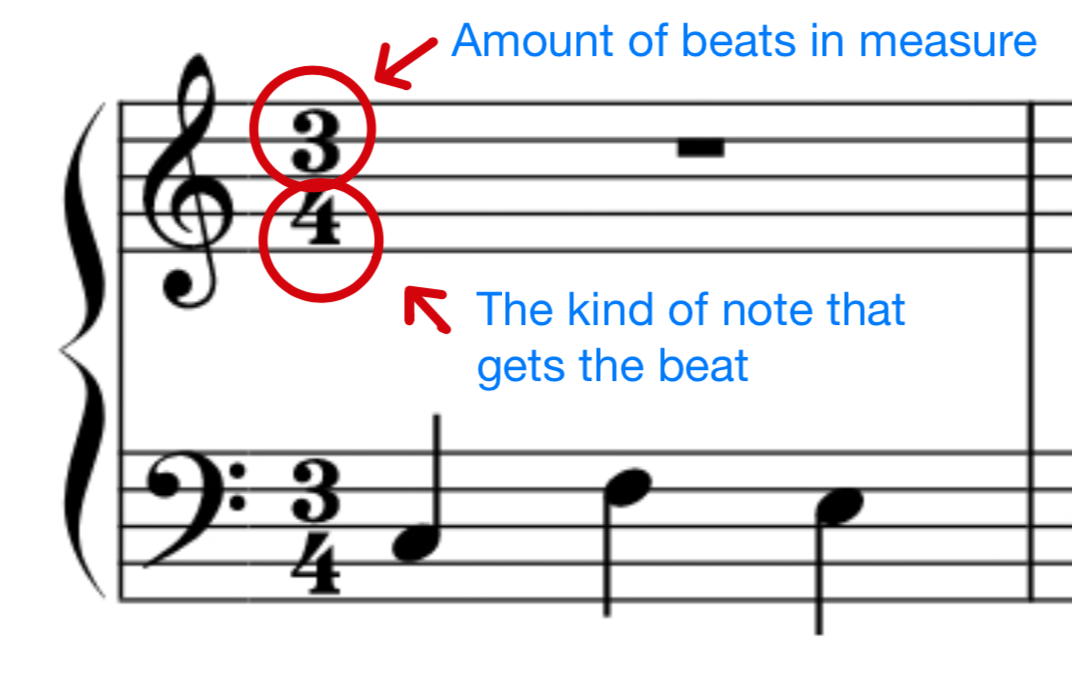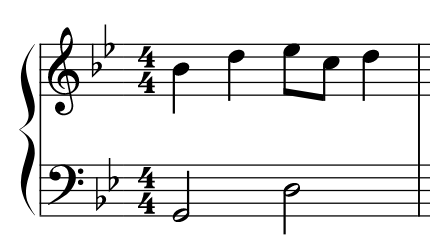Mickey Hansen
Mickey Hansen
AP Music Theory 🎶
72 resourcesSee Units
Time Signatures
During the last unit, we went over how time signatures relate to meter in musical time. To review, in music, a time signature is a symbol written at the beginning of a piece of music that indicates the number of beats per measure and the type of note that receives one beat. The time signature serves as a way to notate the rhythmic structure of a piece of music, and it helps musicians understand how the beats in a measure are divided and how the notes in a measure are to be played.
The time signature shows us the relationship between the number of beats in a measure and the type of beat that is used. The top number gives you the number of beats or beat divisions per measure, and the bottom number gives you which note is counted as one beat or beat division.

The bottom number may not be quite as overt with its meaning, like the top number, but with a quick trick, you can find the value of each beat in no time (so punny!) 🤦. While the time signature is not a fraction, for this trick, you will take away the top number and replace it with a 1.

Keep the bottom number as is, and create a fraction. In the example above, you would receive the fraction 1/8. What kind of note is 1/8? The 8th note, of course!
While we say that the 8th note gets the "beat" colloquially, this might not always be true. 2/8 time is a simple meter, meaning that each beat is usually divided up into 2s and 4s. But we might also have compound meters, like 6/8 time. In compound meters, each beat is subdivided into 3, and the top number gives how many beat divisions there are per measure. The bottom number gives the value of the beat division. So, 6/8 time has two beats per measure.
The best way to figure out whether a meter is simple or compound is to listen to the piece and try to "feel" the beat. However, there are a few heuristics that might clue you into what type of meter it is. For more, read the guide for unit 1.6!
Duple, Triple, and Quadruple Meters
In addition to classifying meters as simple and compound, we can also classify them as duple, triple, and quadruple. In short, duple meters have 2 beats per measure, triple meters have 3 beats per measure, and quadruple meters have 4 beats per measure. Remember, there are beats -- not beat divisions. Examples of duple meters are 2/4, 2/2 and 6/8, examples of triple meters are 3/4, 3/8, and 9/8, and examples of quadruple meters are 4/4 and 12/8.
🦜 Polly wants a progress check! Can you figure out which of these examples are simple and which of them are compound?
Now, we can classify each time signature is simple duple, simple triple, compound triple, etc.
Asymmetrical Meters
Not all meters fall into this category, although quite a few of them do. One example of a different meter is an asymmetrical meter, which is a meter whose beats don't divide up evenly. For example, 7/8 time has beat divisions of 2-2-3. It is unlikely that you'll have to work with these extensively on the AP exam, but you should know how to recognize an asymmetrical meter.
Commonly Used Time Signatures
In music, there are some time signatures used very commonly, and you should know how to spot them and where they are usually used. Sometimes, the time signature will give you clues about other characteristics of the music as well! Here are a few examples:
- 4/4: This time signature indicates that there are four beats per measure, and a quarter note receives one beat. 4/4 is one of the most common time signatures in Western music, and it is often used in dance music and other forms of music that have a strong, straightforward beat.
- 3/4: This time signature indicates that there are three beats per measure, and a quarter note receives one beat. 3/4 is often used in waltzes and other forms of music that have a more flowing, graceful feel.
- 2/4: This time signature indicates that there are two beats per measure, and a quarter note receives one beat. 2/4 is often used in march music and other forms of music that have a strong, military-style beat.
- 6/8: This time signature indicates that there are six beats per measure, and an eighth note receives one beat. 6/8 is often used in music that has a more complex, syncopated feel, and it is often used in folk music and other forms of music that have a strong sense of groove or pulse.
- 9/8: This time signature indicates that there are nine beats per measure, and an eighth note receives one beat. 9/8 is often used in music that has a more irregular or syncopated beat, and it is often used in folk music and other forms of music that have a strong sense of groove or pulse.
You may have also seem 4/4 denoted as common time with a "C." This is, in fact, because 4/4 time is very common. Cut time is denoted with a "C" and a line down the middle, and it stands for 2/2 time.

Image via Carnegie Mellon University
Strong Beats and Weak Beats
Take a look at this excerpt of music:

In the image above, we can deduce that the 12 gives us a compound meter, and it is also a quadruple meter. Basically, this tells us that there are 4 "big beats", indicated in the bass clef by the dotted quarter notes, and each of those beats is divided into three 8th notes, as shown in the treble clef. We would say this time signature is a compound quadruple.
The strong beats in a piece of music are typically the beats that are accented or emphasized in some way. For example, they might be played louder or longer than the weak beats. The weak beats, on the other hand, are typically played softer or shorter than the strong beats.
What would a piece in this meter sound like? On the metrical level, we might notice that the first of each of the four beats is the "strongest" -- in other words, it has more emphasi than the other beats. The first beat of every measure is called the downbeat and is always the strongest unless otherwise noted in the musical composition. The subsequent beats in a measure are considered weaker beats.
The strong beats in a piece of music are typically the beats that are accented or emphasized in some way. For example, they might be played louder or longer than the weak beats. The weak beats, on the other hand, are typically played softer or shorter than the strong beats.
The placement of strong and weak beats can vary depending on the style of music and the time signature of the piece. In duple meter, for example, the strong beats are typically the first and third beats of a measure, while the weak beats are the second and fourth beats. In triple meter, the strong beats are typically the first and fourth beats of a measure, while the weak beats are the second and third beats. In quadruple meter, the strong beats are typically the first and third beats of a measure, while the weak beats are the second and fourth beats.
All the strong beats aren't equally strong, and the weak beats aren't equally weak. The downbeat is almost always the strongest. The halfway point of a measure is often considered the second strongest. Take a look at this measure in 4/4 time:

In a 4/4 measure, such as above, the first beat will be the strongest, followed by beat 3. Beats 2 and 4 are weak beats, also known as offbeats. Often, in rock concerts, we actually clap on the offbeats!

🦜 Polly wants a progress tracker: With your favorite popular song (any genre) can you find the offbeats? Where is beat 1? Can you hear the strong and weak beats?
We sometimes call the last beat of a measure, which is typically an offbeat, and upbeat. It is leading into the next measure, and we consider it as preceding the downbeat rather than ending the measure. You might notice that some pieces of music start with just the last note of one measure. If a piece of music starts on an upbeat, that upbeat is called an anacrusis.
We might also want to analyze metrical accents on a smaller level. Within a beat, usually the first note within the beat division is the strongest, and the next notes are weaker.
Anomalies in the Meter
There might be several reasons why composers might choose to deviate from the meter of a piece. It builds tension, creates musical interest, and might signal the end of one section and the beginning of another section.
Hemiola is a musical term that refers to a rhythmic effect in which the meter of a piece of music is temporarily altered by the use of conflicting rhythms or time signatures. Hemiola often involves the superimposition of duple and triple meter, or the alternation between duple and triple meter, in a way that creates a sense of tension or instability.
One common way to create hemiola is to play a duple meter pattern over a triple meter background, or vice versa. For example, if a piece of music is in triple meter and has three beats in a measure, a hemiola effect could be created by playing a pattern of two quarter notes followed by a dotted quarter note, which would create a feeling of duple meter within the triple meter. Alternatively, if a piece of music is in duple meter and has two beats in a measure, a hemiola effect could be created by playing a pattern of three eighth notes, which would create a feeling of triple meter within the duple meter.
Here is an example:

Image via Music Theory Academy
Usually, hemiola make the meter seem longer. They are very common in French Baroque music to signal an arrival point. Latin music such as Cuban rhythms, Afro-Caribbean, and other Latin music types use hemiola often as well. You might also see these in the works of Brahms, Ravel, and Tchaikovsky.
Browse Study Guides By Unit
🎵Unit 1 – Music Fundamentals I (Pitch, Major Scales and Key Signatures, Rhythm, Meter, and Expressive Elements)
🎶Unit 2 – Music Fundamentals II (Minor Scales and Key Signatures, Melody, Timbre, and Texture)
🎻Unit 3 – Music Fundamentals III (Triads and Seventh Chords)
🎹Unit 4 – Harmony and Voice Leading I (Chord Function, Cadence, and Phrase)
🎸Unit 5: Harmony and Voice Leading II: Chord Progressions and Predominant Function
🎺Unit 6 – Harmony and Voice Leading III (Embellishments, Motives, and Melodic Devices)
🎤Unit 7 – Harmony and Voice Leading IV (Secondary Function)
🎷Unit 8 – Modes & Form
🧐Exam Skills
📚Study Tools

© 2024 Fiveable Inc. All rights reserved.